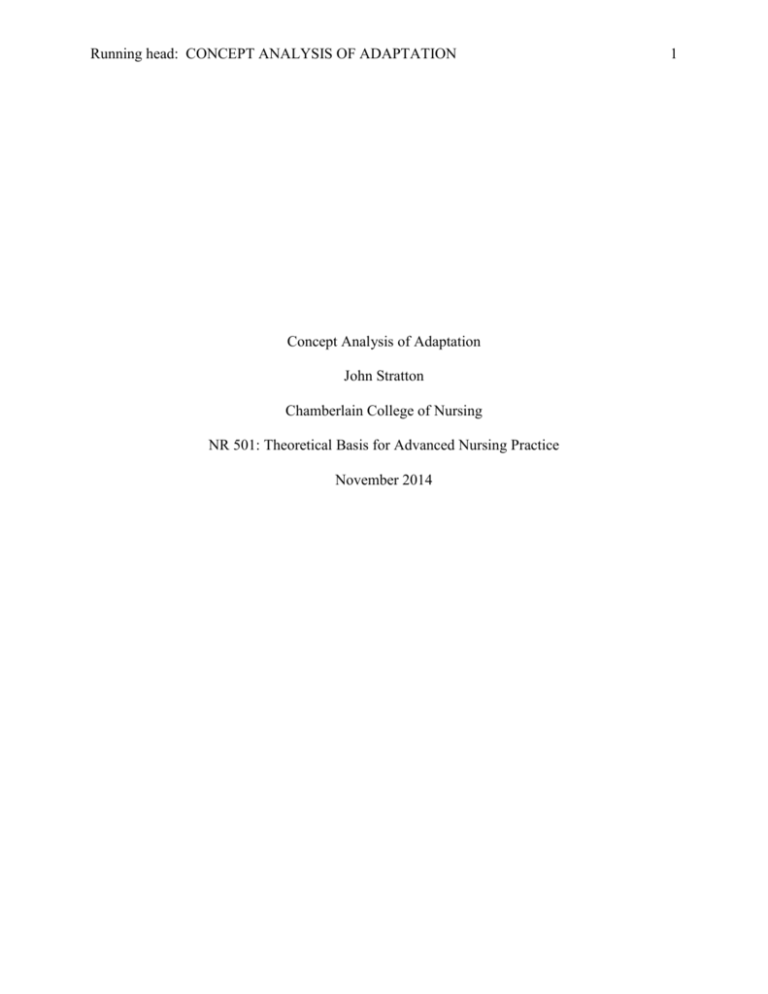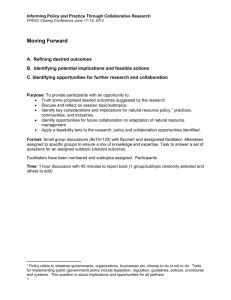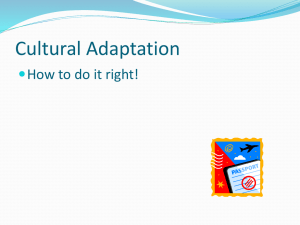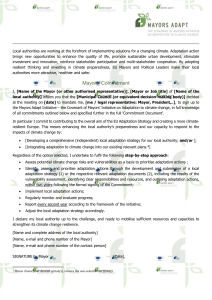
Running head: CONCEPT ANALYSIS OF ADAPTATION
Concept Analysis of Adaptation
John Stratton
Chamberlain College of Nursing
NR 501: Theoretical Basis for Advanced Nursing Practice
November 2014
1
CONCEPT ANALYSIS OF ADAPTATION
2
Concept Analysis of Adaptation
Concept analysis is vital to nursing theory as it allows the writer to elucidate the
definition of terms or concepts used so that both the writer and reader are on the same page, thus
preventing any misinterpretations (McEwen & Wills, 2014). The process of concept analysis has
several steps to ensure an appropriate amount of detail to prevent any confusion. Walker and
Avant provide a framework of six steps, setting a standard that others can use to create their
concept analysis. The following sections discuss the concept of adaptation from the Roy
adaptation model, adapted by Walker and Avant: the purpose of the analysis, literature review,
possible uses of the concept, attribute definitions, model cases, alternative cases, antecedents and
consequences, empirical referents, and finally the conclusion.
Purpose of Analysis
This analysis considers the concept of adaptation from the Roy adaptation model and
how patients exhibit adaptation in a vast number of settings. This will show how nursing practice
can utilize adaptation to guide nursing interventions. Bakan and Akyol write that use a variety of
studies in an array of settings the Roy adaptation model (2008), showing the versatility of the
adaptation concept. With such a versatile concept, it is important for both the reader and writer to
have the same definition of adaptation thus a thorough concept analysis is complete.
Literature Review
The many articles on adaptation show how it applies in different settings and
interventions. This literature review will cover three journal articles showing adaptation for
different diseases and settings. Bakan and Akyol show how adaptation, when applied to
interventions for heart failure, produces significant positive outcomes for the patients (2008).
Akyil and Ergüney find that utilization of the Roy adaptation model can lead to increased
CONCEPT ANALYSIS OF ADAPTATION
3
adaptation to chronic obstructive pulmonary disease (Akyil & Ergüney , 2012). Rogers and
Keller identify that through adaptation older sedentary adults have improved physical function
(Rogers & Keller, 2009). These articles show the importance of adaptation and how it applies to
a variety of settings and diseases; through this, we learn that adaptation is the key to positive
outcomes.
Patients exhibit positive indicators of adaption when their coping processes lead them to
self-promoting behavior. Rogers and Keller write that using nursing interventions with sedentary
older adults that promote adaptation leads to the patients having positive outcomes such as
increased physiological function (2009). Akyil and Ergüney provide insight into positive
outcomes related to patients with chronic obstructive pulmonary disease and their education of
their disease (2012). Through their knowledge of their disease, they show signs of adaptation,
and therefore promoting education for the patient and their support system greatly affects their
outcomes (Akyil and Ergüney, 2012). Bakan and Akyol show that patients with heart failure
adapt to their disease when utilizing interventions that promote adaptation (2007). Adaptation is
key for patients to adjust to their disease process and promote positive outcomes. These
outcomes do not arise from doing nothing, but through nursing interventions that promote
positive reinforcement, a support system, and education.
Through these three articles, the concept of adaptation is consistent with the methods
used. One of the methods used in all three was the need to educate the patients. As the patients
understood their disease process and had the knowledge of their situation, along with the positive
effects of health promotion, the patients exhibited positive indicators of adaptation. Education of
the patients in the Akyil and Ergüney study produced positive improvements in their adaptation
to chronic pulmonary obstructive disease (2012). Knowledge of the negative effects of a
CONCEPT ANALYSIS OF ADAPTATION
4
sedentary lifestyle in Rogers and Keller’s article and promotion of activity encouraged their
patients to adapt (2010). Bakan and Akyol educated not only the individual but also the family
support system to promote positive outcomes in patients with heart failure (2007). These authors
have found that they get positive indicators of adaption when they utilize teaching strategies and
increased knowledge of the patients’ disease.
There are several strengths to each of these studies. Bakan and Akyol argue that there is
strong evidence related to the exercise capabilities of those who suffer from heart failure (2007).
Rogers and Keller identify that positive outcomes come from the promotion of exercise and
knowledge for the sedentary adult (2010). Akyil and Ergüney identify that education in those
with chronic pulmonary obstructive disease has a positive effect on the four modes of adaptation
identified in the Roy adaptation model (2012). The validity and commonality between the
positive adaptation to diseases through education and exercise is apparent in all of these studies.
Akyol and Ergüney, and Bakan and Akyol present that the weakness in their conclusions
stem from the lack of previous studies that support their ideas of increased adaptation in those
who are educated more on their disease (2012)(2007). Bakan and Akyol also identify the need
for a larger sample size (2007). Rogers and Keller identify some exogenous variable that can
effect their results; these include age, gender, level of education, and ethnicity (2010).
Possible Uses of Concept
To understand the concept of adaptation one must first define it. Roy identifies adaptation
as “the process and outcome whereby thinking and feeling people, as individuals or in groups,
use conscious awareness and choice to create human and environmental integration” (pp. 26,
2009). Merriam-Webster defines adaptation as “a change in a plant or animal that makes it better
able to live in a particular place or situation; the process of changing to fit some purpose or
CONCEPT ANALYSIS OF ADAPTATION
5
situation” (“Adaptation,” n.d.). In biology, adaptation is defined as the “process by which an
animal or plant species becomes fitted to its environment” (Gittleman, 2014). Adaptation is the
change that a person undergoes to become more responsible and knowledgeable about their
disease and its processes (Akyil and Ergüney, 2012). There are several definitions for adaptation
so we must look back at our purpose.
For the purpose of this paper, adaptation is an individual or group undergoes as a
transformation to allow awareness and to adjust to changes in their environment. Through the
articles, the reader can note that adaptation is a necessity for individuals. Without adaptation, the
individual may have difficulties, thus resulting in setbacks, such as additional hospitalizations. It
is imperative for patients to understand their disease and respond appropriately to promote
change. Through this change, the patient will not only better understand their disease, but also
promote positive outcomes, such as increased activity tolerance and decreased knowledge deficit
about their situation.
Defining Attributes
For this analysis of adaptation, we will look specifically at cases that promote both
education and positive outcomes. More specifically, the use of the Roy adaptation model along
with its four bio-psycho-social response modes and how they lead the patient to the adaptation
level of their disease. These response modes include physiological, self-concept, role function,
and interdependence. Through an intervention program that consisted of several interactions with
the patient, including in-person and over-the-phone, Bakan and Akyol were able to show that the
intervention group had statistically more adaptation in those patients in relation to four
adaptation modes (2007). Akyil and Ergüney also had their intervention group exposed to oral
and print education in which the patients were able to show adaptation in relation to the four
CONCEPT ANALYSIS OF ADAPTATION
6
adaptation modes (2012). Some defining characteristics of a model case include adaptation using
the Roy adaptation model, education that promotes adaptation, and positive outcomes throughout
any number of the four bio-psycho-social response modes.
Model Cases
Bakan and Akyol and Akyil and Ergüney present model cases for adaptation. Both of
these cases look at the framework set out in the Roy adaptation model and how Bakan and
Akyol’s study covers the four mode. Bakan and Akyol identify that for a patient to get to the
adapt to a disease, exposure to the environmental stimuli must occur and the patient must take
part in the bio-psycho-social response modes (2007). Bakan and Akyol’s study was a
randomized trial that involved 44 patients who were literate, could communicate verbally, and
diagnosed with heart failure a minimum of six months prior to the study (2007). Using the Roy
adaptation model framework they created one-on-one counseling sessions, phone calls, and a
group meeting over a three-month period—during these sessions patients were educated using
both print and verbal methods (2007). With the utilization of education and self-management
strategy patients, show positive outcomes of a higher activity tolerance and fewer
hospitalizations (Bakan and Akyol, 2007).
The second model case by Akyil and Ergüney was a quasi-experimental case that
included outpatients diagnosed with chronic pulmonary obstructive disease for at least six
months, no other additional disease, and the ability to read and write (2012). This study had
sixty-five patients, thirty-two of them were in the intervention group, which had both verbal and
written education; this included one-on-one interviews along with phone education (2012).
Following the interviews at the end of the study there was confirmation of the hypothesis and
that the interventions did create better adaptation to the disease with improvement in the four
CONCEPT ANALYSIS OF ADAPTATION
7
adaptation modes (Akyil and Ergüney, 2012). These two cases have several things in common
and highlight the model case. Both studies utilized the Roy adaptation theory, provided verbal
and written education to the participants, positive outcomes for the intervention group, and
progress in all four of the adaptation modes.
Alternative Cases
The model cases above highlight the Roy adaptation model and how education of the
patient can correspond to such positive outcomes as increased adaptation to the chronic disease.
Hacihasonğlu and Gözüm performed a study utilizing a pre-test and post-test on patients with
hypertension, concluding that education of medication adherence and healthy lifestyle behaviors
have positive outcomes, such as decreased hypertension and decreased body mass index ( 2011).
This case did not use the Roy adaptation model nor focused on the four adaptation modes. Even
though they did not use the Roy adaptation model they still had a positive outcome through use
of education sessions and individual instruction (Hacihasanoğlu & Gözüm, 2011). One could
argue that their study showed that the patients adapted to their chronic disease through education
and an increase in their knowledge of their disease.
In a study by Serçekuş and Mete on the effects of antenatal education and its relationship
to postpartum adaptation, it showed that education had no statistically significant difference
between the control and intervention group (2010). This study did utilize the Roy adaptation
model and provided education to intervention group on postpartum adaptation. This study was
not on patients with a chronic disease nor did the results correlate with those of the two model
cases. One answer to this could be that the patients were not randomized due to the fear that
those who did not want the additional education would not show up (Serçekuş & Mete, 2010).
This study did find that the education utilizing the Roy adaptation model was beneficial to
CONCEPT ANALYSIS OF ADAPTATION
8
prenatal adaptation, but had little effect on postpartum adaptation (Serçekuş & Mete, 2010). This
study identifies the application of the Roy adaptation model to a variety of settings and patients,
yet the antenatal education did not have an effect on postpartum adaptation.
Antecedents and Consequences
An identified antecedent for a positive outcome related to education using the Roy
adaptation model would be the presence of a chronic disease. When a chronic disease is present
before education, a patient is more likely to take the education and use it to adapt to the chronic
disease. Akyil and Ergüney support that with chronic obstructive pulmonary disease; the patients
who were open to being educated on their disease process were able to adapt better than those
who were not (2012). Bakan and Akyol’s study of those with heart failure presented the same
finding, with those who had heart failure and were educated were more adaptable to their disease
process (2007). The patients who were more adapted to their disease were able to read and write
and possessed a chronic disease that they were open to being educated on. Thus, adaptation to a
disease must have a chronic disease present and the willingness on the patient’s part to learn how
to better take care of them.
The consequence to adaptation is that the patient will understand their disease process
more thoroughly, resulting in fewer hospitalizations and better control of their disease. This is
evident in Bakan and Akyol’s study, as their patients that underwent the education had a greater
quality of life, which includes “functional abilities, social support, physiological findings, and
emotional status” (pp. 606, 2007). Using the Roy adaptation model Akyil and Ergüney identified
that those who participated in the educational sessions were more adapted to their disease and
shown an improvement in interpersonal support (2012). With adaptation, you will find a patient
has a higher quality of life, which can include both their physical and their psychosocial health.
CONCEPT ANALYSIS OF ADAPTATION
9
Empirical Referents
Promoting adaptation and measuring its positive effects throughout the four adaptation
modes can be difficult as it is an abstract concept. One empirical indicator a researcher can use to
easily quantify a study’s success is a questionnaire. Akyol and Ergüney utilized the adaptation
evaluation form along with the perceived social support from family and friend (2012). Bakan
and Akyol utilized the “Minnesota Living with Heart Failure Questionnaire” along with the
interpersonal support evaluation list and six-minute walking test (2007). These questionnaires
guided researchers into understanding and quantifying the progress of the patients in relation to
the four adaptation modes. Another empirical referent is to identify if the education promotes
adaptation by the presence of an educational plan. This plan should include both verbal and
written communication and should be offer it throughout the length of the study; a successful
educational plan concludes with the patient having better control over their disease process,
which is identifiable by increased activity tolerance and increased quality of life.
Conclusion
Adaptation comes from the Roy adaptation model and applies easily to an array of
disease and settings. Through adaptation, a patient with a chronic disease can improve their
quality of life. Using Walker and Avant’s steps of concept analysis, we discovered how the Roy
adaptation model applies to nursing interventions and produce adaptation in a variety of patients.
Our model cases identified studies that used the Roy adaptation model to create educational
strategies that had positive outcomes allowing patients to adapt to their disease process. These
positive outcomes include an increased quality of life, and thus a more successful interaction
with the medical care system.
CONCEPT ANALYSIS OF ADAPTATION
10
References
Adaptation - Definition and More from the Free Merriam-Webster Dictionary. (n.d.). Retrieved
from http://www.merriam-webster.com/dictionary/adaptation
Akyil, R. C., & Ergüney, S. (2012). Roy’s adaptation model-guided education for adaptation to
chronic obstructive pulmonary disease. Journal of Advanced Nursing, 69(5), 1063–1075.
doi:10.1111/j.1365-2648.2012-06093.x
Bakan, G., & Akyol, A. D. (2008). Theory-guided interventions for adaptation to heart failure.
Journal of Advanced Nursing, 61(6), 596–608. doi:10.1111/j.1365-2648.2007.04489.x
Connelly, L. M. (2014). Use of theoretical frameworks in research. MEDSURG Nursing, 23(3),
187–188.
Gittleman, J. (2014). Adaptation (biology and physiology) -- Encyclopedia Britannica. Retrieved
from http://www.britannica.com/EBchecked/topic/5263/adaptation
Hacihasanoğlu, R., & Gözüm, S. (2011). The effect of patient education and home monitoring on
medication compliance, hypertension management, healthy lifestyle behaviours and BMI
in a primary health care setting: Effect of patient education and home monitoring.
Journal of Clinical Nursing, 20(5-6), 692–705. doi:10.1111/j.1365-2702.2010.03534.x
McEwen, M., & Wills, E. M. (2014). Theoretical basis for nursing (4th ed.). Philadelphia:
Wolters Kluwer Health/Lippincott Williams & Wilkins.
Parker, M. E., & Smith, M. C. (Eds.). (2010). Nursing theories and nursing practice (3rd ed.).
Philadelphia: F.A. Davis Co.
Rogers, C., & Keller, C. (2009). Roy’s adaptation model to promote physical activity among
sedentary older adults. Geriatric Nursing, 30(2), 21–26.
doi:10.1016/j.gerinurse.2009.02.002
CONCEPT ANALYSIS OF ADAPTATION
11
Roy, C. (2008). The Roy adaptation model (3rd ed.). Upper Saddle River, NJ: Pearson Prentice
Hall.
Serçekuş, P., & Mete, S. (2010). Effects of antenatal education on maternal prenatal and
postpartum adaptation. Journal of Advanced Nursing, 66(5), 999–1010.
doi:10.1111/j.1365-2648.2009.05253.x
Walker, L. O., & Avant, K. C. (2011). Strategies for theory construction in nursing (5th ed.).
Norwalk, CT: Appleton, Lange.










